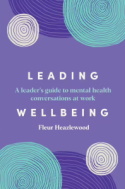Kelly Greenwood* discusses ow organisations can support women’s mental health in the workplace.
 While men and women have similar rates of mental health conditions overall, women face specific challenges around mental health in the workplace.
While men and women have similar rates of mental health conditions overall, women face specific challenges around mental health in the workplace.
Some are tied to gender roles and stereotypes, and some are intersectional in nature.
Mental health is intersectional, since identity markers such as race and gender shape an individual’s experience; it’s also an emerging diversity, equity, and inclusion (DEI) category in and of itself.
The list of challenges affecting women is long.
For one, women are more prone to certain diagnoses.
They are twice as likely as men to experience depression, generalised anxiety disorder, and PTSD, and much more likely to battle eating disorders.
Pay inequity, caregiving responsibilities, and gender-based violence are among the contributing risk factors to common mental health conditions.
Infertility, menopause, and postpartum depression also affect many.
Physical and emotional caregiving roles — as daughters, mothers, colleagues, and even leaders — result in heavier burdens.
Then there’s being underrepresented in leadership at work, navigating “double only” status as a woman of colour or member of the LGBTQ+ community, enduring sexual harassment, dealing with imposter syndrome, juggling parental leave, and having office housekeeping roles.
Many of these challenges are largely invisible, since women may be reluctant to discuss them at all, much less at work.
Add these up, and it’s no surprise that gender adds another layer of complexity to workplace mental health.
The structures and systems of most companies were built with men in mind.
Many women may not be inclined to “other” themselves further by disclosing a mental health challenge.
Between my gender and generalised anxiety disorder, I’ve had a lot to navigate, and I’ve done my fair share of covering.
This has been the case in environments ranging from male-dominated management consulting at the start of my career to my current role as founder and CEO of Mind Share Partners, a non-profit driving culture change on workplace mental health.
Here’s what to do if you’re a woman struggling with your mental health at work, or if you’re a leader who wants to create a mentally healthy environment for your female employees.
Many of these recommendations are standard to supporting mental health at work, but the nuances and context of being a woman make applying them much more difficult.
How can women advocate for their own mental health at work?
Despite the systemic issues at play, there are practical ways that you can advocate for your mental health in the workplace.
These include identifying and asking for what you need, finding allies and safe spaces, talking to your manager or HR, and evaluating your culture to decide whether it supports you in the ways you want.
Reflect on your needs.
First, think through the nature of your mental health and your specific challenge.
Is it chronic, episodic, or a one-time event? Consider the contributing factors.
Are they work-related or limited to your personal life?
Is there a gender-specific component, like childcare or workplace discrimination, that might make you more reluctant to discuss the problem at work?
Be clear about the effects.
Is your mental health challenge affecting your work performance?
Talk with a friend, family member, or therapist about your concerns and brainstorm the potential asks that you could make at work to support yourself.
You may also want to get advice from a women’s circle or ask female friends to recommend therapists, books, or podcasts that focus on gender.
Consider whether seeking out the mental health benefits and other resources your employer provides (such as healthcare coverage to see a therapist or psychiatrist) is sufficient or if you need an accommodation (such as starting your workday later).
It may help to educate yourself about the legal protections available to you.
Find allies and safe spaces.
The first person I ever disclosed my generalized anxiety disorder to at work was a female mentor who had previously opened up about a family member’s mental health struggles.
Without this knowledge, I wouldn’t have had the courage to seek her guidance when I was underperforming as a direct result of my anxiety.
Given the stigma often associated with mental health challenges, finding a safe space to tell your story and receive support from allies is a critical step.
Simply realizing that you’re not alone can go a long way, especially when you may be feeling othered because of your gender.
This can happen one on one or through your company’s women’s affinity group or mental health employee resource group.
Peer support is a powerful lever to reduce stigma.
Allies can help you see that mental health challenges can be useful for developing workplace strengths.
Combined with the added difficulty of navigating gender at work, allies can teach us empathy and resilience, can spur creativity, and can fuel our ambition.
If there aren’t any obvious mental health allies at your company (of any gender), look for potential indicators.
Has someone expressed vulnerability or talked authentically about personal challenges of any kind?
Has a male leader referenced his working wife or daughter in a supportive way?
Test the waters to see how they respond to, say, a celebrity who’s been in the news for talking about her mental health or an upcoming fundraising walk in your community to support a mental health organisation.
Then consider seeking their advice on how to navigate your specific workplace.
Talk to your manager or HR.
If you need accommodations for your mental health or have suggestions that could benefit everyone, talk with your manager (or HR if you don’t feel comfortable with your manager).
This can be scary.
Mind Share Partners’ 2021 Mental Health at Work Report found that women respondents were less comfortable talking about their mental health to managers and HR than men were, but no difference existed when talking to colleagues or friends.
Power dynamics are at play, sometimes made more pronounced by gender.
You may fear putting an already hard-to-come-by promotion in jeopardy or othering yourself with a mental health challenge or stereotypically “female” concern such as childcare or eldercare.
You control how much you choose to share and with whom.
Your ask can be as simple as, “Could I take Friday off? I’ve been feeling a little burned out lately.”
You might mention your diagnosis, if you have a close, trusting relationship.
If your proposed solution involves changes to workplace factors that could benefit everyone on your team, such as increased flexibility or norms around after-hours response times, you might introduce the idea of a work style conversation with your manager.
This sets up everyone to do their best work and supports mental health without having to name it.
Should you require a separate accommodation, you’ll likely have to say a bit more and ideally work with your manager and HR to co-create a solution.
Even in a female-led workplace, my own self-stigma and fear of professional repercussions were so strong that, as a new hire trying to prove myself, I didn’t ask for the simple accommodation to see my therapist in-person weekly.
Had I done that early on, I would have saved my manager, organisation, and myself a lot of hardship.
Reflect on the trade-offs of sharing; they may increasingly be weighted toward disclosure as mental health challenges become more normalised, especially among high performers.
Evaluate the culture.
While quitting is a last resort when your job is hurting your mental health, it should always be on the table.
Before you make that decision, take a step back and consider your company’s culture.
Are there women in leadership? Anyone who has openly talked about their mental health or other challenges? Is the executive team open to feedback and change?
Is it committed to DEI and new ways of working that promote balance and wellbeing?
You shouldn’t have to jeopardize your mental health to earn a living.
Fortunately, companies are realizing that more and more as employee priorities around mental health play out through recruitment and retention.
It’s OK to walk away from work that isn’t working.
The 2021 Mental Health at Work Report found that 68 per cent of millennials and 81 per cent of Gen Zers have left jobs for mental health reasons, compared with 50 per cent of respondents overall.
The report also found that women were less likely than men to positively view their organisation’s culture around mental health.
A study from Deloitte showed that women who work for gender-inclusive organisations have higher levels of mental well-being and loyalty to their employers.
To compete for talent, companies will have to make changes, as younger generations are increasingly prioritising their mental health and the work cultures that support it.
How can leaders support women’s mental health?
Unless we’re in positions of power, there is only so much that individual women can do to advocate for our mental health.
Leaders, managers, and HR must drive culture change to correct for historically male-dominated workplaces.
To do just that, we offer the following advice, much of it adapted with women in mind from the Mind Share Partners’ Ecosystem of a Mentally Healthy Workplace framework.
Provide mental health training and over-communicate resources.
Leaders must prioritise mental health training for people at all levels, including executive teams, managers, and individual contributors.
Due to generational and other differences in the workplace, everyone should have the same level of understanding, including how mental health intersects with the various aspects of our identities — gender and otherwise.
Take a proactive, preventive approach with a management lens.
It isn’t necessary to dive into signs and symptoms.
Mental health training should provide baseline knowledge, discuss intersectionality, dispel myths, and offer tools and strategies to navigate workplace mental health, such as how to have difficult conversations and create mentally healthy cultures.
In addition, leaders should regularly communicate about the mental health benefits available.
These should be embedded in company-wide emails at least monthly and be prominently featured on the intranet, instead of buried deep within a benefits portal.
Since many people delay seeking treatment due to stigma, leaders should ideally also share if they have personally used the benefits, to normalise doing so.
This should also be true of other benefits that women may not want to discuss openly, such as those for infertility.
Build mental health into policies, practices, and measurement.
Name mental health explicitly in relevant policies and incorporate it into organisation-wide practices.
Examples include paid time off and leaves as well as flexible hours and healthy communication norms.
Companies should establish a genuine commitment to DEI, including having executive sponsors and funding for employee resource groups.
In addition, leaders must rectify structural issues that harm women, such as pay inequity, insufficient parental leaves, and lack of consequences for microaggressions and harassment.
Leaders can incite positive changes through accountability mechanisms such as regular pulse surveys.
Measuring female employee engagement, retention, and dimensions of mental health cements the support of women’s mental health as an organisational priority.
Foster inclusive flexibility and sustainable ways of working.
Workplace factors such as lack of autonomy, unrealistic workloads, and lack of boundaries after hours can lead to poor mental health.
For women, these can be even more detrimental due to microaggressions, caregiving responsibilities, and other factors.
I often avoid mentioning my two small children to external male stakeholders for fear of biases about my capacity to simultaneously be a mother and a driven entrepreneur.
Leaders should build as much flexibility as possible into policies and practices.
Every woman and every individual will need something different, be it remote work or flexible hours.
Be sure to revisit this with your direct reports since shifts happen over time and with life changes, such as parenthood.
Leaders should model sustainable and flexible work practices themselves.
Otherwise, female employees are unlikely to change their behaviour, for fear of negative implications for their careers.
Even in the most supportive environments, we typically have to unlearn a lifetime of conditioning — be it workaholism or mental health stigma.
Many women learn to put their own needs last, to be people pleasers rather than to speak up for themselves, and to do the extra emotional labour required to balance being strong and nurturing leaders.
This can make prioritising mental health at work exceedingly difficult.
We should give ourselves grace and remember that we can only be effective once we’ve first taken care of ourselves, including our mental health.
Be the change.
Authentic leadership is an extremely effective, evidence-based way to gain trust and lessen stigma.
Being vulnerable and sharing about your own mental health or other challenges is one of the most powerful things you can do.
It signals to employees that they can discuss what was once taboo in the workplace and helps them feel comfortable sharing.
While it was a long time coming, I now freely talk about my past mental health challenges and push myself to share my current struggles in real time to benefit my team.
These range from debilitating depression that led to a leave of absence, to grief about my dad’s unexpected passing immediately before the Covid-19 pandemic, to hot flashes due to perimenopause, which felt particularly off limits, given my early days in male-dominated consulting.
Revealing that last one ended up being an unexpected win since my team gifted me a mini desk fan that plugs into my laptop! Members of my team have told me how refreshing it is to see a female leader be vulnerable.
As a result of my sharing, they can freely discuss their own mental health and personal challenges for the first time ever at work, allowing us to offer support and adjust as needed.
Modelling mentally healthy behaviours and building a culture of connection are also essential, especially for women, who may be hesitant to disrupt the status quo.
Just telling people that it’s OK to take a vacation or log off after working hours does nothing if you don’t follow that same advice.
For example, I put my therapy appointments and events for my kids’ school on my work calendar.
My team knows that they can also prioritise important personal things during the workday and that kids can pop into our video meetings.
Checking in regularly on a personal level with each of your direct reports fosters a caring and inclusive culture.
This can be as simple as reserving the first five minutes of a meeting to genuinely ask, “How are you, and how can I help?”
Reorienting to supporting women’s mental health at work will ultimately benefit everyone, from dads who want to be more involved parents to Gen Zers who expect flexibility by default.
Hopefully there will come a time when we won’t have to separate out the needs of women, but instead will have achieved true culture change and inclusion.
*Kelly Greenwood is the Founder and CEO of Mind Share Partners, a non-profit that is changing the culture of workplace mental health so that both employees and organisations can thrive. She can be contacted on Twitter @KellyAGreenwood.
This article first appeared at hbr.org.











